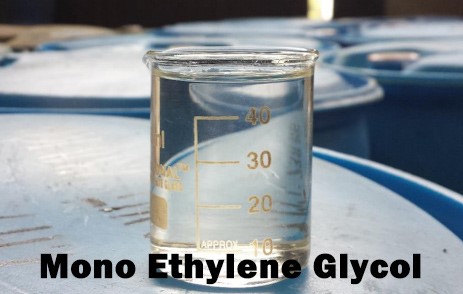Description of Mono Ethylene Glycol
Mono ethylene glycol (also known as MEG, EG, 1,2-ethanediol or 1,2-Dihydroxyethane) is an organic compound with the formula C2H6O2. It is a slightly viscous liquid with a clear, colourless appearance and a sweet taste that emits virtually no odour.
It’s miscible with water, alcohols, and many other organic compounds and is primarily used in the industry for manufacturing polyester fibres and as a component in the production of antifreeze, coolants, aircraft anti-icers and de-icers.
It is mainly used for two purposes, as a raw material in the manufacture of polyester fibers and for antifreeze formulations. It is an odorless, colorless, sweet-tasting, viscous liquid.
MEG is produced from ethylene via ethylene oxide, which in turn is hydrated by using either a thermal or catalytic production process.

Uses Of Mono Ethylene Glycol
Ethylene glycol is primarily used in antifreeze formulations (50%) and as a raw material in the manufacture of polyesters such as polyethylene terephthalate.
End uses for MEG range from clothing and other textiles, through packaging to kitchenware, engine coolants and antifreeze. Polyester and fleece fabrics, upholstery, carpets and pillows, as well as light and sturdy polyethylene terephthalate drink and food containers originate from ethylene glycol.
The humectant (water attracting) properties of MEG products also make them ideal for use in fibres treatment, paper, adhesives, printing inks, leather and cellophane.
Industry uses
A primary industry use of mono ethylene glycol is in antifreeze applications where it is a component in the manufacture of antifreeze, coolants, aircraft ani-icer and de-icers due to its ability to depress the freezing temperature of water.
It is also used in hydraulic brake fluids and cooling systems such as in vehicles and air-conditioning units as it acts as a coolant and heat transfer agent.
There is strong global demand for MEG in the plastic industry as it is a vital ingredient in the production of polyester fibres, films, and resins, one of which is polyethylene terephthalate (PET).
PET is then converted into plastic bottles which are used globally. It is estimated that 70-80% of all the MEG consumed is used as a chemical intermediate in these polyester production processes.
MEG is also used as a solvent in paints and electrolytic condensers, as a desiccant in gas pipelines to prohibit the formation of clathrates, as a chemical intermediate in the production of capacitors, as an industrial humectant in fibres, adhesives, cellophane, synthetic waxes.
It is also found in other industrial products such as plasticizers, processing aids, adhesives, additives and surface treating agents.
Consumer Uses
Mono ethylene glycol is found in many consumer products such as antifreeze, ani-icer, de-icers, brake fluids, adhesives, automotive care products, cosmetics, toners, fabrics, inks, pens, paints, plastics and coatings.
Applications of Mono Ethylene Glycol
Minor uses of ethylene glycol include the manufacture of capacitors, as a chemical intermediate in the manufacture of 1,4-dioxane, as an additive to prevent corrosion in liquid cooling systems for personal computers, and inside the lens devices of cathode-ray tube type of rear projection televisions.
Ethylene glycol is also used in the manufacture of some vaccines, but it is not itself present in these injections. It is used as a minor (1–2%) ingredient in shoe polish and also in some inks and dyes.
Ethylene glycol has seen some use as a rot and fungal treatment for wood, both as a preventative and a treatment after the fact. It has been used in a few cases to treat partially rotted wooden objects to be displayed in museums.
It is one of only a few treatments that are successful in dealing with rot in wooden boats, and is relatively cheap. Ethylene glycol may also be one of the minor ingredients in screen cleaning solutions, along with the main ingredient isopropyl alcohol.
Ethylene glycol is commonly used as a preservative for biological specimens, especially in secondary schools during dissection as a safer alternative to formaldehyde. It is also used as part of the water-based hydraulic fluid used to control subsea oil and gas production equipment.
These applications are vital to the manufacture of a wide variety of products, including:
- Resins
- Deicing fluids
- Heat transfer fluids
- Automotive antifreeze and coolants
- Water-based adhesives
- Latex paints and asphalt emulsions
- Electrolytic capacitors
- Textile fibers
- Paper
- Leather









